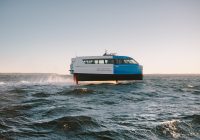From the mid 1950s to the late ’60s and early ’70s, everything was – or seemed to be – much more colourful, stylish and distinctive, be it automobiles, clothing, record players (remember them?) or home appliances. The same maxim applied to the marine industry, especially outboards, where decals and graphics and, in many cases, the entire exterior colour tint of a motor, changed every year. In fact, if a dealer had any sort of tenure with a particular brand, that dealer could pretty much identify the model year simply by looking at the cowling graphics.
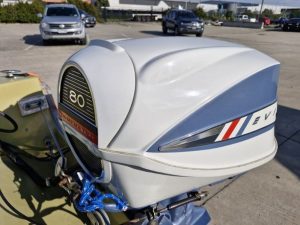
There was no greater example of this practice than the Evinrude and Johnson motors from the Outboard Marine Corporation (OMC) – every model year had distinctive styling tweaks.
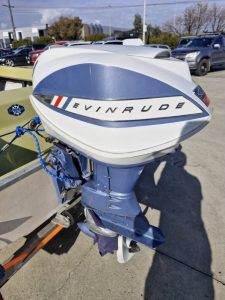
There was a little more consistency with Johnson, which, in the ’60s, never strayed far from its trademark white covers and green outer castings, but the motors from its in-house sibling, Evinrude, were always a bit “outré”, thanks to the famed industrial designer, Brooks Stevens. Stevens was responsible for the styling on Evinrude motors right through to the late ’70s.
The motor shown here – a 1966 Evinrude Starflite 80 hp (affectionately known to all OMC diehards as a “Jumbo”) – is a fine example of Brook Stevens’ design at its zenith. From my perspective, the engine covers were a little intricate and contrived (maybe even a tad ugly from some angles) in comparison with the more staid and less garish Johnsons, but there is little doubt about their striking presence.
This fully restored Starflite 80 (this unit may have been gold originally, but trademark Evinrude Blue was always an option) is on a period Swift Craft 1500 and belongs to a dealer mate of mine who – like me – loves boats and motors from this golden era. It uses the famous – and, for the period, extremely reliable – Selectric (i.e. push-button electric) gear shift. It was one of OMC’s most reliable and relatively sprightly “oversquare” V4s at 89.5 ci (1,466 cc), weighing just over 110 kg – about the same as a modern 60 hp 4-stroke. And it loped languidly along, producing 80 hp at a leisurely 4,500 RPM.
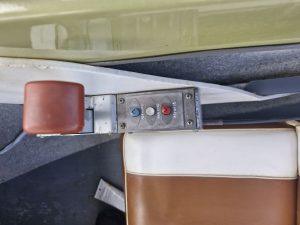
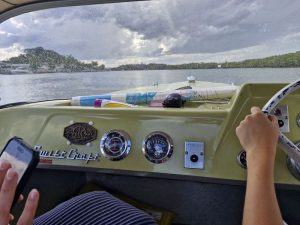
This was one of the first OMCs with fixed high-speed carburetor jets (the low-speeds were still adjusted by opening the front flap and twirling the knobs), but at full throttle or working hard pulling a mono skier, it would still have been capable of emptying a standard 23-litre portable tank in a little over 30 minutes!
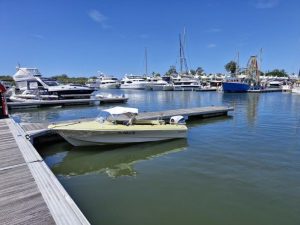
One of the images shows the period speedometer and tachometer working perfectly, with 3,300 RPM equating to just over 30 MPH. Numbers like this are not possible from a modern outboard, but these old V4s ran very “tall” gearing, with a ratio of 20/23 (1.15:1 – almost direct drive!) so these numbers, assuming a propeller of maybe 11″ pitch, are feasible. But the best thing about this old Jumbo would undoubtedly have been the heady, intoxicating whiff of an oil/fuel mixture wafting in the breeze – I’m getting moist-eyed already!
Danny Casey is highly experienced, undoubtedly idiosyncratic, and immensely knowledgeable about things mechanical, new or old. His knowledge and passion are as a result of spending his whole life in or around anything power-driven – especially marine engines. His passion for boating is second to none, with his life a montage of fabulous memories from decades spent in or around water and boats, both here and in Europe. Danny has spent myriad years in the recreational marine industry in a varied career in which he has bamboozled colleagues and competitors alike with his well-honed insight.

His mellifluous Irish accent, however, has at times been known to become somewhat less intelligible in occasional attempts at deliberate vagueness or when trying to prevent others from proffering a counter-argument or even getting a word in. Frank and to-the-point, but with a heart of gold, it can be hard to convince Danny to put pen to paper to share his knowledge. Marine Business News is grateful for his contributions. Connect with Danny through LinkedIn.





